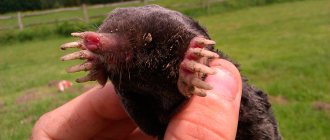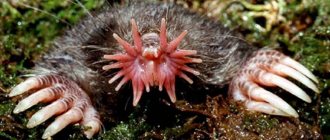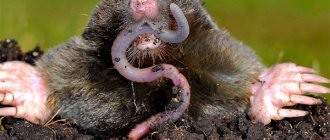Moles in the garden are a fairly common occurrence. And this is not surprising, since moles lead an underground lifestyle, feeding on various bugs and worms that live deep in the earth. These animals move quickly in the thickness of the earth, choosing looser and more fertile soil, in which there is always something to find for food.
Due to the fact that the mole digs peculiar labyrinths underground, it damages the roots of various plants, and also leaves visible furrows on the surface of the earth, which do not look very pleasant, since they can pass through the plantings of various crops. Therefore, the question immediately arises of how to get rid of this animal, despite the fact that it is still a useful animal under certain conditions. In fact, it is not so easy to get rid of it, although sometimes it leaves the area on its own and moves to another. Due to the fact that the mole is underground and it is difficult to calculate its location, there are not many means of combating it. To choose the most suitable method, you should familiarize yourself with some of them.
What is a wormhole
Let's start with the fact that this animal does not really like to look out into the white light (if you can say that about it). The fact is that the mole is blind due to his lifestyle. Its habitat is the upper layers of soil. There he feels quite comfortable and cozy. Before asking how deep the mole's hole is, you need to find out why he needs it. After all, such a “structure” depends on goal setting. Nature does not like empty movements. In any case, the wormhole proves precisely this principle. The animal devotes almost all its time to its work on “underground construction”. He debugs and improves it. A wormhole is a whole system of corridors and rooms, each of which is created for its own purpose. There are passages, a latrine, a nest, and a warehouse. Of course, all terms should be placed in quotation marks. However, they carry a practical load very similar to that which we put into the corresponding names. For example, a latrine is used by an animal as a “toilet room.” Moreover, in other places the animal does not fulfill this natural need.
The auditory openings are also covered with skin. But the animal’s hearing is remarkably developed.
Which sense organs are better developed in a mole? The frequency sound conductivity of the soil is available to it. The sense of smell is well developed. By smell, he finds food in the ground.
Tactile hairs are distributed throughout the body. Thanks to them, he senses worms located 50-70 cm away from him.
Also an integral part is a 2-centimeter tail, which is covered with hairs. When the mole lifts its tail up, it feels the ceiling of the dug tunnel. If he does not feel the ground, he returns to his hole.
Features of digging holes and passages
Animals dig underground passages for food. This is a complex deep network of multi-level galleries. Depending on their purpose, tunnels are of two types:
In summer, the first ones are not located too deep - up to 5 cm. In cold times - deeper. Narrow and long feeding tunnels provide some kind of bait for worms. They are attracted by the musky smell of animals. Feeding passages can cover an area of hundreds of square meters. And during the night the animal is able to dig a tunnel up to 60 m long. In this case, there is no release of soil to the surface. Moles only lift a layer of earth above themselves.
Residential tunnels - from 20 cm and deeper. The animals use them to move from the nesting chamber to feeding areas or watering places. Sometimes a deep mole hole has access directly to a pond. The animals are good swimmers and can even swim across a small river.
The nest, as a rule, is located in a safe place (among the roots, under snags) at a depth of up to 2 m.
In open areas with drier soil, the depth of mole burrows is no more than 50 cm.
By digging deep tunnels, insectivores throw up small piles of soil - mole hills. These earthen mounds can be especially large above the network of nesting tunnels - about 80 cm.
The mole does not hibernate and is active all year round. The animal overwinters in the same places where it spends the rest of the time, without moving in search of a new home. We can say that his life in winter is not much different from the summer: he still digs tunnels in search of food.
The only difference is that the main part of the tunnels in winter is located at a depth of approximately 10 cm.
Here is food for the animal - various worms and larvae. The mole goes deep underground just to rest.
Often the animal digs passages directly under the snow cover and even in the snow itself, making holes for its multi-level network of passages.
Why does a mole build a hole?
Let's immediately determine that there are many animals with this name. We're talking about everyone for now. They, of course, have their own characteristics. Only in this part of the article will we talk about a certain “middle mole”. Let's consider the functions of his home. There he spends almost his entire life. Note that the depth of a mole's hole is determined by the tasks for which it is dug. In general, it consists of several floors. The first lies ten to twenty-five centimeters from the soil surface. This floor consists of a system of passages. The animal needs them to look for food. After all, it is precisely “hiding” in this layer of soil. The mole descends below for other purposes. He creates the second (in depth) floor in order to breed offspring and preserve his reserves. This is described quite well in a famous fairy tale. The mole's hole, as shown there, is its warehouse, home, place for hunting, harvesting, etc. promenade.
Underworld
The mole, as you know, lives in the ground, to penetrate into the thickness of which it digs holes in a helical manner, turning into the ground and raking it with its paws. The paws are perfectly adapted for this; they have huge (a third of the paw) claws and powerful muscles.
These animals have almost no vision due to the fact that they spend their entire lives in underground passages, rarely reaching the surface, where they become clumsy and helpless. Another thing is in the ground, where they lay numerous passages that have their own system and purpose. These passages are divided into residential and feeding passages: moles walk along the residential passages from the nest to the feeding compartments or to the watering place. Food plots serve as traps for worms, which moles feed on. But the main structure is the nest, which is located at a depth of up to two meters in a protected place, under stones, buildings or tree roots. The nest is, in a certain sense, cozy: the mole lines it with leaves and dry grass, and brings feathers and mosses.
Thus, all passages form a coherent system of galleries with passages 5 centimeters in diameter, with aft compartments located very close to the ground. Those holes in the ground that are visible to the human eye actually serve only to throw out excess soil.
At what depth do they live?
Still, let's figure out at what depth moles live. The depth of habitat at any time of the year remains almost unchanged - up to 50 cm. It makes no sense for the animal to dig deeper passages because it costs too much energy. After all, at great depths they are no longer able to raise the ceiling of the passage; they have to push the dug up soil with their hind legs to the surface. And the deeper you have to dig, the more problematic it becomes to carry out this titanic work. A deep hole occurs only in one case - when moles arrange a nesting chamber for sleep and rest.
In winter, the mole eats less than in summer, and sinks deep into the soil following the worms. For the winter it makes food reserves, which, as a rule, consist of earthworms. The animal bites off the heads of invertebrates, thereby paralyzing them. Worm reserves can be located along the entire length of the tunnels or hidden in a special chamber. Sometimes in the burrows and passages of an animal you can find up to five thousand invertebrates prepared in this way.
In a cold, snowless winter, when the soil freezes to a depth of more than 50 cm, animals die from lack of food.
At the same time, thanks to their warm fur, moles are not at all afraid of frost. They can get out even in winter, but they still prefer to stay under the snow and crawl out from under it infrequently. The main enemy of the animal in winter is precisely hunger.
Adults prefer a solitary lifestyle. They protect their territory from their own kind and can bite to death.
Cannibalism is even common among moles. At the same time, many predatory animals do not eat animals because of their specific musky smell.
The mole comes to the surface very rarely - due to the structural features of the front legs, which are adapted for digging, the animal does not walk, but crawls.
Mole tunnels often attract other animals. For example, shrews climb into them and eat all the worms. And in winter, the passages are used by rodents of the mouse and hamster families.
Many people only know about the small animals living in the village from cartoons. We are talking about moles. Not many have seen them in the natural environment. And when they noticed it and examined it, they got scared. Their forelimbs look so bright. And, of course, not every person can tell how deep a mole’s hole is. For non-specialists, this interesting topic often remains a “closed secret.” But in fact it is quite educational. Not only biologists, but also people of other specialties study this topic in detail, keeping in mind its practical application. Let's not lag behind either. It might come in handy!
Read also End of October nature photos
Star-nosed
Star-nosed mole The second name for the mole is star-nosed. It differs from its relatives by its unusual nose. The stigma consists of 22 soft processes - tentacles. Thanks to them, the animal gropes for food. The rest of the body structure is similar to the European mole.
- The mole's body is elongated, about 22 cm long.
- The tail is long - 8 cm.
- The coat is thick, soft, silky, black and brown in color.
- There are no auricles.
- Small eyes are not covered by skin.
The starfish swims and dives well. The mole feeds on crustaceans, slugs, earthworms, larvae, and mollusks. In addition to the underground, aquatic lifestyle, it leads a terrestrial one. It can build nests in rotten stumps, hollows of old trees, under leaves. Prefers swampy areas, soil with high humidity. Often found near rivers, lakes, and swamps in the United States.
Like a mole digs the ground
Engineers, as well as biologists, were interested in how a small animal manages to build such a complex structure. It should be noted that the depth of the mole hole sometimes reaches four meters. For comparison, its dimensions are about twenty centimeters. Do you feel the difference? Its structure can be compared to our high-rise buildings or mines. The animal uses almost all parts of its body for construction. It is equipped with naturally powerful front paws with claws. They are what frighten casual witnesses of his rare appearance on the surface. The animal uses them to scrape away layers of soil. They just need to go somewhere. In order to remove excess “building material”, the animal makes molehills. These are small exits to the surface through which it pushes soil. This is done with the head. When the corridor becomes too long, the animal clogs up the used hole and digs a new one. And a person sees piles of earth on the surface - the results of the mole’s work. You just can't find the entrance there. The animal hides it cunningly enough so as not to be in danger, and to save its offspring.
Economic importance of moles
During the Soviet Union, people highly valued mole fur. The beautiful velvety skins of the animal are very durable; they were used for sewing fur coats. Such fur coats were not the warmest, but they were in fashion and cost a lot of money.
In the middle of the last century, mole fishing in the USSR was in full swing. Animal skins were harvested in significant quantities throughout the country, especially in the Urals and central Russia.
Nowadays, the fashion for mole fur coats has gone, and along with it, such a craft has lost its significance. In some regions of Russia, moles continue to be caught and their skins are used for making clothes. But the volume of such catching is quite insignificant.
Reproduction
In Belarus, the mating period for moles begins shortly after the snow melts. In the western and southern regions, pregnant females begin to be seen from April 17, and in the northern regions - from May 5-8. Early and cold spring delays this period, which entails a prolongation of the mating period, birth dates, feeding of the young and their settlement. This leads to the prey of a large number of pregnant and lactating females, and consequently to an overall reduction in the mole population.
The duration of pregnancy in females is 35–40 days. The largest number of pregnant females occurs in May. Most females give birth to 6 cubs. On average, there are about 5 cubs per female.
Females usually have one litter per year. However, on the territory of Belarus, especially in the western and southern regions, it was found that 20–25% of females bear litters twice. The second, summer, offspring occurs from the end of June to the end of July. Signs of a female that has given birth to a second offspring are well-developed mammary glands, nipples (4 pairs of them), around which the hair is wiped. In summer, female fertility is lower than in spring: there are about 4 cubs per female.
Feeding the young continues for about a month. At this time, females often fall into traps. Young moles live peacefully among themselves, but as they mature they become pugnacious. At the age of two months, in the middle or end of June, young moles, the size of which does not exceed 3/4 of an adult animal, begin to be caught in traps. They already lead an independent lifestyle. From the end of June - beginning of July, their mass resettlement begins, which ends by the end of August.
In the first days of settlement, young moles run along the tunnels several at a time. Often young moles can be found on the surface of the earth, where they crawl out through holes in passages or molehills. Sometimes it is possible to catch with one mole trap during the summer, in a course in which all the moles go in one direction, up to 50 or more specimens, of which young animals account for up to 75%.
Moles spread very quickly, as they run along ready-made passages at a fairly high speed—up to 6 m per minute. Research by scientists shows that young moles cover a distance of up to 700 m in 20.5 hours, and adults cover 50 m in 20 minutes. Young moles are more prone to movement than adult moles; the latter do not go further than 400 m in 11 months.
We suggest you read: Mealybug - how to fight it on indoor plants
Material prepared by: horticulture specialist Buinovsky O.I.
The moles' rut begins with the period of snow thawing. The mating period for moles begins in early spring (March-April). Before the onset of mating season, males expand their burrows in search of females. Their genitals are significantly enlarged.
Pregnancy in a female lasts about 40 days. The cubs are born helpless, naked and blind, weighing only 2-3g. As a rule, females give birth once a year, 4-6 cubs are born. The mother constantly guards the offspring, with the exception of the time when she is getting food. At the age of 1 month, the offspring reaches the size of an adult mole. As the cubs grow older, they become pugnacious and do not get along well with their fellows.
After reaching the age of 1-1.5 months, the young leave the nest and begin searching for their own site. During this period, young animals are most vulnerable to predators.
A mole lives on average 3-5 years.
Year-round hard work
Moles remain active throughout the year; in winter they can make their burrows even under the snow or deeper, where the soil does not freeze. Constant movement and aeration of the earth is a condition for the survival of the mole, which breathes ordinary air; for the same reason, moles do not settle on clay soils.
Adult moles are usually attached to their areas, they do not change them throughout their lives and usually always return to them, even from very long distances. Young moles leave their parental nests at a distance of up to two kilometers and there begin an independent life. Moles do not live in pairs; they unite only during mating games; after the female becomes pregnant, the male leaves her nest.
What does a mole eat?
It is clear that with such a specific lifestyle, the animal must have a special diet. And they eat everything they meet along the way. These are mainly plant parts. Roots, tubers, acorns - all this ends up in their stomachs (and not only). Researchers of this interesting animal say that its reserves can be impressive. For example, the mole rat makes several storerooms in which up to twenty kilograms of food can be found. Agree, one can envy the animal’s hard work. In addition, this factor explains to what depth the mole digs. Stocks are being made for the winter. Therefore, they should not “disappear”, in particular from the cold. This means that in those areas where there is more frost, the animal hides deeper and vice versa.
Where do they live?
The animals live mainly in humid areas: river floodplains, forest edges, meadows, river valleys. Moles cannot chew soil, like rodents. Therefore, they usually settle in soft, loose soil. Very often they appear in our gardens and vegetable plots.
Animals feed on small invertebrates - mainly earthworms, to a lesser extent woodlice, centipedes, spiders, chafer larvae, caterpillars, etc. Sometimes they can even attack a mouse or lizard if they are motionless.
Thanks to their fast metabolism, the animals are very insatiable and within a day they are able to eat an amount of food that is not much less than their own weight. They can remain without food for no more than 17 hours.
Construction method
Externally, a mole hole looks like small loosened tubercles of soil. The animal digs the ground with its front paws, which are shaped like a shovel and equipped with long, sharp claws. With the help of such equipment, the densest soil can be easily loosened.
The absence of large ears and a sharp muzzle make it easy to move underground, calmly get worms, and catch insects. With its hind legs, the animal throws the soil back and then transports it out. The places where the deep hole is located are marked from the outside by embankments.
In numerous labyrinths, other inhabitants of the underground world can settle; very often they become mice and earth rats. However, the mole does not give up without a fight and calmly drives the invaders out of his possessions.
Benefits and harms
The settlement of moles on a plot of land is assessed in two ways. In the fields, these creatures loosen the soil, saturate it with oxygen, and increase fertility. However, when there are large numbers of people on earth, they become a real disaster and you have to fight the moles. They damage root crops and grain crops and make harvesting difficult.
There is even more damage from burrows on a small plot of land, in the garden. Gardeners and gardeners try to scare away pests and clean the area. The settlement of moles in the neighborhood helps to scare away mice, get rid of shrews, mole crickets, and May beetles.
Mole and vegetable garden
People involved in agriculture often complain about animals. The fact is that mole rats often settle next to areas cultivated by humans. Considering how much he can “steal” from the garden, some are starting to worry. It must be said that the negative attitude towards moles is not entirely justified. Well, let them eat some potatoes or carrots. At the same time, they also diversify their diet with larvae and other parasites, which can spoil much more of the harvest. This conclusion was reached by experts who found out how a mole digs a hole. This very first floor is intended for feeding. Where the animal lays it, no parasites remain. He catches them all and eats them. So it turns out that the underground hunter is very useful to gardeners, even though for his “services” they have to share the harvest. But, by the way, moles are still considered pests. They are trying to get rid of them.
How to recognize molehills?
Not only a mole can dig the ground on a site. Similar activity is also typical for gophers, mole rats, and voles. Identifying the pest is important because it determines the strategy to combat it.
Moles dig tunnels under the surface of the earth. Such passages are called stern passages. Animals also dig another type of tunnel under the feeding tunnels, combining them into one network. It is because of them that characteristic piles are formed, reminiscent of mini-volcanoes.
The mole rat is larger than a mole; the piles of earth it digs up are almost half a meter in diameter, and it can weigh 10 kg. They form mounds and gophers, but their shape resembles a horseshoe. Voles also dig passages, but they do not leave heaps, but make visible passages under the surface or on it with a diameter of 5 cm.
Summarizing
There is no clear and universal answer on how to properly remove a mole from a garden plot. Each gardener decides for himself: leave the mole on the site and scare it away from the beds, but allow the pests to be destroyed in other parts of the garden, or destroy it.
Most gardeners consider moles to be beneficial, and in some countries they are listed in the Red Book and it is considered a violation to kill them.
Those who have fought moles know that defeating a pest invasion is a difficult, long task, and often fails. It is unlikely that it will be possible to drive away the animal forever. A mole will not leave an area rich in food and worms. From time to time it may go deeper, leave the beds and move to another part of the garden, but as soon as the influence of the repellent factors stops, it will return.
We protect the area from moles using a fence
Fighting moles is an endless process. In place of some, others will always come. If you want to break the endless circle, make an underground fence around the perimeter of the site. To do this, bury a metal or plastic mesh with a fine mesh to a depth of at least 70 cm. Old slate or roofing felt is suitable for these purposes. In fact, you need to create a barrier that will prevent passage to your property.
Burrow length
People, considering the performance achieved by this small builder, focus on the depth of the structure. But there is a more interesting factor that may capture the imagination. Agree, many people can bury themselves four meters into the ground in a straight line. But building tunnels whose length is many times greater than your size is a huge job. So, this figure can reach up to three hundred and sixty meters (for a mole rat). And it is still unknown whether this is a record. The fact is that many species of moles have not been thoroughly studied. Science knows only general information about them. No one measured the length and depth of their holes. These include, for example, shrews. They are much smaller than moles. They can live unnoticed “under your nose” (in your garden). By the way, shrews are considered useful. They loosen the soil and eat pests.
Have you heard the blackbirds sing? I have no doubt they heard and enjoyed it. How do moles dig in your area? If fortune, by an unfortunate chance, turns its back on you, then the sensitive ear of the gardener will catch this “wonderful” sound. And then piles of excavated earth - mole hills - will disfigure your beloved lawn. And let them repeat that a mole on the plot is like a raven in the heights, like a crayfish in the water - an indicator of the purity of the environment, the most “kind” feeling experienced when seeing a mound in the middle of a cucumber bed is annoyance: why did they choose me?!
A cute animal from a Czech cartoon in real life ruins your mood in an instant. Pyramids of earth, erected overnight, and sometimes brazenly, right before our eyes, are the pinnacle of that beautiful city of trenches, tunnels and passages that each mole family digs. And if the soil in the field has dried up, which means the amount of food for moles has decreased, then expect guests to come to you, because you have fertilized the soil, it is fertile, fatty, and there are a lot of all kinds of larvae, worms, bugs and other food in it. By the way, moles do not hibernate, they only go deeper underground, where they wait out the winter in “preserves”: each one stores up to a kilogram of earthworms as live canned food. Such diligence requires serious work: by eating earthworms, larvae and insects, the mole digs up to 20 meters of underground passages in a garden or vegetable garden per day. It’s a shame that in addition to its beauty, the site also suffers biologically. Moles often dig tunnels directly under plants, causing their roots to hang in the air. Such a plant, cut off from nutrition, soon dies.
Humanity has come up with many ways to deal with the hardworking animal. The abundance of anti-mole methods suggests little effectiveness, but still, let’s not give up.
One of the radical methods is as follows. At the very beginning of spring, the perimeter of the area is surrounded underground (vertically) with a special plastic or galvanized mesh made of small cells. The mesh is buried to a depth of 1.2 meters with an exit of 30 centimeters to the outside. Digging to a shallower depth will not give any result. The mesh must be intact, without holes, otherwise the mole will find and certainly use them. The method is very labor-intensive. For example, if you take a plot of 6 acres, then the length of its perimeter will be approximately 100 meters. It will take a lot of effort and time to dig a hundred-meter trench.
An even more radical and inhumane method is killing with rat poison. Yes, he is capable of killing a mole. If the mole eats the poison. But how to get him to eat pickled grain? Craftsmen came up with the idea of using earthworms, cut into pieces and sprinkled with poison, as bait. The worms move for about 20 minutes - this is enough for the mole in the area to smell it, crawl and eat the treat. But I don’t even want to discuss such a knacker’s method, let alone resort to it.
You can get rid of moles, if there are only a few of them, in a simple and accessible way: a fresh mound is dug up right up to the opening in the tunnel, after which the wait begins for the mole to come “to do repairs.” All that remains is to deftly pick up the mole rat with a shovel and carry it over the fence to where far away.
An interesting trap with the philosophical name “Solomon’s trap” was invented by fighters against the mole regime. It looks like a cylinder 40 centimeters long, and the diameter is about the size of a mole hole. Made from galvanized iron or sheet metal. There are hanging doors at both ends of the pipe that only open inward. The Solomon's Trap is placed in a mole tunnel and covered with soil. Now all that remains is to wait for the mole to get into it.
To avoid setting useless traps in holes abandoned by moles, press down the mound with your foot, press down on the ground, and return to it after a couple of days. The Mole will restore this move if he uses it regularly. Set the trap there.
There are a lot of mole repellent units on sale. These are small devices that stick into the soil and produce sounds at low frequencies, extremely unpleasant for moles and inaudible for people. They need to be used correctly and applied not just one, but several pieces per site. If the size of your plot is more than six acres, install repellers in a checkerboard pattern at the operating distance of each (20-25 meters). The device needs to be rearranged from time to time. The mole can get used to the location of the signal point and learn to bypass it.
The method of killing animals using water is not very effective. The water hose is simply inserted into the hole. If there is water in the holes, the mole will not be able to live in them and will move to another place. But what he will choose - a neighboring plot, a field behind a fence, or a familiar place rich in worms 20 centimeters from a flooded hole - is difficult to predict. And the costs of fighting an uncertain outcome are too high. Firstly, you need a lot of water (at least 100-150 liters per mole) to flood all the passages. One bucket of water will only attract earthworms, which are their food, so instead you will only double the problem. Secondly, it is very difficult to completely fill all underground passages (air jams, etc.). And thirdly, moles dig very quickly (up to six meters per hour), so they can dig a passage above the water level and, after everything is absorbed, begin to make holes in your area again.
And finally, the old, ancient methods. They are still used today, which means they help someone:
- We plant plants in the area whose smell moles cannot stand: beans and black beans (the side shoots and tops of legumes can be placed directly in the tunnels). They can be planted in places or along the border of the site. Some flowers - daffodils, decorative onions, imperial hazel grouse and Siberian scilla, marigolds - are also not favored by moles and may scare them away.
- The mole has a very acute sense of touch and smell. With a generous hand, we place rotten fish, herring heads, rags soaked in kerosene, and naphthalene throughout the garden (including in holes). Just keep in mind that a mole can ruin this job, so you need to place the aromas in different points of the underground labyrinth.
- We put special bombs with sulfur smoke into the minks (you will just have to breathe, and the mole may go deeper for a while).
- The next repelling method is based on the fact that the mole has excellent hearing. (By the way, he also has vision, only his eyes are always covered with fur so that earth does not get into them.) So we will influence the hearing: we cut off reeds 1.5-2 meters long and insert one piece into each hole. The plant should protrude 60-80 centimeters above the ground surface. During windy weather, reeds create the effect of “the howling of the wind in a chimney,” which apparently frightens not only people, but also animals defenseless against mysticism. They say that moles disappear in almost a week. And they say they don't come back. Empty bottles stuck into holes at an angle of about 45 degrees work the same way.
- Personally, I used thin-walled aluminum beer cans and plastic bottles mounted on metal sticks. The principle is simple: a metal rod (a piece of reinforcement, a water pipe) is driven deep into the ground (1-1.5 meters), and an empty beer can is placed on it. The wind blows, the can rings and howls, the rod resonates, the sound and vibrations irritate the mole, and he runs away in panic to the neighbors.
But the most reliable remedy against moles, in my experience, is to get a dog. Our dachshund Gavrik so tirelessly and briskly stomps on the “ceiling” of the mole’s apartment that the unfortunate people do not consider such a life to be a life and avoid the area. Moreover, Gavrik has the patience to stand over a dug-up mound, waiting for the “repairman” mole. Of the three underground inhabitants, I saved (and expelled from the dacha village) two; the third, alas, fell victim to our big-eared hunter, who rejects a humane attitude towards our smaller brothers. But with the advent of the dog, and this is a fact, we forgot about the attack. The lawn is in perfect order. And now we are keeping blackbirds away from Gavrik.
A tireless worker in a luxurious velvet coat is forced to build tunnels in the ground every day. He needs a large amount of nutritious food that can support his vigorous activity.
Complex labyrinths underground
If you plot the underground passages of moles on paper, you will get a complex diagram of passages and labyrinths. The mole is an excellent digger. As soon as he enters a new area, his task is to find a secluded place to build a nest.
The choice will be given to a piece of land under a large tree, bush, something that will reliably protect from above. Expands the lair by compacting the earthen walls.
at what depth do moles and mole rats dig holes?
The nest has a convenient spherical shape and is located at a safe depth of about 1 meter underground.
The main tunnels diverge radially from the lair; they are wide and lie at a depth of 7 to 25 centimeters. The walls are tightly compacted so that they do not crumble during use and allow the mole to move quickly. These passages serve as tunnels for many years if the animal is not disturbed and driven away from the site.
Once the laying of the main “highways” is completed, the mole digs underground passages that connect them and lead to the main lair. This allows the mole to quickly leave the move in case of danger. At the end of the main passage, the mole makes several vertical exits to the surface of the earth. The end of the main passage is determined by the number of closely spaced molehills.
Scheme of mole labyrinths: 1 - nest, 2 - main passage, 3 - circular passages, 4 - vertical tunnels and molehills.
At what depth moles dig tunnels depends on their purpose. On the surface of the earth there are long ridges of loosened soil with frequent molehills. This is a move of the mole under a layer of soil no more than 3-5 cm , so as not to push the soil in front of itself, the animal throws the excess out. Close to the surface there is a lot of food, for which the mole “furrows” a piece of land.
Mole tunnels are located on several tiers, all connected to each other. The animal uses surface tunnels to search for food. Permanent highways serve for movement to feeding areas. The passages in them contain small depressions (chambers), which the mole uses for short-term rest. Depth up to 25 centimeters underground.
Siberian or Altai mole
A variety of common mole. It differs from its relatives in its large size. Lives in Siberia and Mongolia.
- The mole's body size is about 20 cm. Females are slightly smaller.
- The length of the tail does not exceed 4 cm.
- The eyes are round, small, and have a movable eyelid.
- The muzzle is elongated, with a well-defined nose.
- The ears are small, almost invisible.
- The mole's shovel-shaped front paws have long claws; the hind paws are similar to rat limbs.
- The coat is dark black, but can be smoky, yellow, or brown.
- The Siberian mole weighs from 100 to 225 g.
A distinctive feature of this type of mole is its long pregnancy. Fertilization occurs in the summer, but the embryo freezes until spring. Cubs appear in April-May. Pregnancy lasts 9 months. There are about 11 cubs in the litter.
The main food is earthworms, followed by beetle larvae, pupae, and small insects. A Siberian mole can easily gnaw on a mouse, lizard, sick rat, mole cricket, snake, snake, or frog. There are cases of cannibalism. The winner takes possession of the victim's possessions, marking his territory with a special secret.
Appearance of the animal
The weight of the European mole is 72-128 g, the body length is 113-159 mm, and the tail is 25-40 mm. Males are larger in size than females. The body of the mole is elongated and cylindrical, covered with thick velvety black fur. The mole's fur grows upward, not backward, which allows the animal to freely move through the underground labyrinth in any direction. The fur color is predominantly matte black, but individuals with an ash or brown tint can be found.
Constant movement through tight tunnels causes the fur to quickly dry out, so moles often molt - 3 or 4 times a year. Most animals shed 1-2 times a year. Moles have the best fur after a complete autumn molt - from the end of October. Overwintered moles change their winter fur one by one: first the females molt, and then the males switch to lower spring fur.
The time of spring molting is from April to June. Moles wear spring fur that lasts until mid-July, then summer molting begins in adult moles. Young moles molt for the first time in late July - early August. Summer molting smoothly transitions into autumn, almost without interruption, so that throughout the warm season, moles molt.
Since the mole lives underground, its eyes are practically not developed. They are very small in size or may be absent altogether. There are also no external ears. The mole's nose is a small movable proboscis that protrudes slightly beyond the front incisors. The hair of a mole's tail is capable of performing a tactile function, thanks to which the mole can move backwards along its moves.
The forelimbs of the mole are well developed. They are curved with their palms outward to make it easier for the mole to dig and have 5 strong claws. The mole uses them as a shovel to dig the ground.
The mole also has a well-developed anterior shoulder girdle, so the animal makes passages in the ground quite quickly.
Its cylindrical, shortened, dense body helps it move through dug tunnels. It is slightly pointed at the front and rounded at the back.
The front part is much better developed. The animal has 6 main species and 11 different varieties. They differ in the structure of the jaw, skeleton, their weight, and size.
Young individuals differ from older mammals in the silvery hue of their skin. The mole has practically no neck. The head seems pulled into the shoulders.
The body smoothly touches the triangular head. On the head there is a proboscis, along the edges of which there are vibrissae. Thanks to these sensitive hairs, the animal finds food.
The mole's forelimbs are wide, everted, and shaped like a shovel. Initially the paws are silver-black. Over time they begin to fade.
There are 5 tightly pressed toes on the feet. They are connected by thin membranes. The claws are elongated, strong, slightly flattened. They reach 10 mm in length.
The hind feet are unwebbed, but with very sharp, elongated claws. The animal has 44 teeth, 2 of which are well-developed upper canines. In adult moles, the fangs are severely worn out.
The size of a male mole from proboscis to tail can reach 115-200 mm, females - from 105 to 145 mm. The weight of males is 90-100 g, females - 60-80 g.
Common or European mole
A real mole, which is often encountered by gardeners, gardeners, and wildlife lovers.
- The body size of the mole does not exceed 20 cm, the average dimensions are 15 cm. The body is oblong.
- The weight of an adult is about 120 g, the tail is no more than 4 cm long.
- The muzzle is elongated, the nose with splayed nostrils is clearly visible. There is nothing else that stands out on the head.
- Mole eyes with small slits without movable eyelids. The mole's vision is weak, but its sense of smell is well developed.
- The fur is soft, thick, short, black. The color on the abdomen is lighter. The tone changes somewhat depending on the time of year. In winter, the wool is the fluffiest and most beautiful. The animal sheds about 4 times a year. A photo of the mole can be seen below.
The mole animal has one striking distinctive feature - spade-shaped forelimbs with long claws. With them the animal digs the ground, screws itself into the passage, and pushes the soil out with its hind legs. In places where holes are dug, mounds are formed - molehills.
The mating season of the common mole begins in early spring and lasts until the end of May. Around June-July, the younger generation appears. There are about 9 moles in the litter. The female carries the cubs for about 30 days. The European mole gives birth only once per season. Carefully takes care of babies for about 2 months.
We suggest you read: The best remedy for bedbugs
The earth mole only appears outside to mate; this happens at night. The rest of his time is spent underground. Digs numerous passages and labyrinths. This type of mole feeds on earthworms, insects, pupae, caterpillars, and less commonly, slugs, lizards, mice, snakes, and frogs.
Where do they live and what is their lifestyle?
Moles can settle in a summer cottage, but this is not their only habitat. In the wild, you can meet these animals in forest areas, as well as near places where people live:
- in the meadows;
- in the gardens;
- on the territory of parks;
- in other green spaces.
Moles prefer to dig holes in moist soil. If it is dry, it will make it difficult for them to dig tunnels. Therefore, they prefer to live in lowlands. Moles feed on earthworms, as well as other invertebrates that live in the soil. It feeds:
- root vegetables;
- grains;
- eat parts of plants;
- earthworms;
- insect larvae;
- centipedes, woodlice.
The largest portion of the diet of these animals consists of earthworms. This is explained by the fact that they are numerous and live everywhere. It can be argued that the mole, while moving through its underground passages, does not neglect any food that comes across its path.
Moles living in the forest feed not only on plants and insects living in the ground, but also on flies, wasps, ants, and insect larvae that they can find.
These animals also prey on mice or small snakes. Almost any creature that wanders into its hole can become its victim. The weight of food that one animal eats is equal to its own weight.
Enemies
These animals have almost no natural enemies. Birds of prey pose the greatest threat to them.
Reproduction
Reproduction occurs starting from March-April. Pregnancy is 40 days. One brood can contain up to 9 cubs.
The lifestyle of these animals is sedentary, but after their birth, young moles move up to 4 km from the place of birth. Their life expectancy is up to 5 years.
Read also: Dahlia seedlings from seeds











